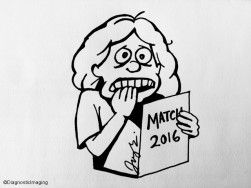Radiology Residency Interviews: The Communication Game
Maybe it's best to stop communicating after the interview.
Landing a residency position is becoming increasingly competitive as the number of graduating medical students outmatches the available GME spots. In fact, between 2001 and 2010, MD enrollment increased by 1.38% annually and DO enrollment increased by 6.64% annually.1
The number of applicants for residency is quickly rising. The AAMC projects an overall 30% increase in allopathic medical school enrollment and 125% for osteopathic graduates in the next few years.2 In contrast, between 2001 and 2010, the number of residents in core and combined specialties increased at 0.90% annually.3 The 2015 Match was the largest in history, with 41,334 applicants vying for 30,212 positions according to the NRMP.
The stakes to obtain a residency position are higher than ever. As the interview season wraps up in the next two months, applicant stress-levels will also rise as 2016 Match day draws closer.
One particular black box in the process is post-interview, pre-Match communication. Post-interview contact is common practice. Between 69% and 95% of program directors follow-up with applicants, and 94% of students reported contacting programs after interviews.4,5
Expressing interest between candidates and programs is an important aspect of the Match process. Communications from applicants after an interview include courtesy thank you notes, phone calls, and e-mails specifying particular interest called “letters of intent.” When programs receive this kind of correspondence, there are mixed reactions. Program directors value applicants’ letters of interest and voluntary commitments, but they also question and doubt these informal letters.6
Applicants also have mixed and often conflicting feelings regarding correspondence from programs. Applicants receive communication from programs during the January to February period that include e-mails filled with words of overwhelming enthusiasm. Sometimes these emails are trying to gauge interest without directly asking the applicant, “How high are you ranking our program?” Nevertheless, applicants feel pressured to respond positively and enthusiastically to any correspondence from programs regardless of their true interest.

On the other hand, not responding at all or an unenthusiastic response is perceived to be detrimental.
In the context of falsely assuring messages, both applicants and programs end up frustrated and suspicious. Up to 90% of applicants and program directors believe that they are lied to during the application process.7-9 Moreover, programs distrust one another as well. Amongst radiology fellowships, 51% of program directors believe that others are not abiding by the rules.8,9
In summary, I believe that any post-interview communication is unnecessary, with exception of informational e-mails. Although the Match is supposed to be designed in favor of applicants, the program directors are the ones holding the power and have more experience. Post-interview communication places applicants in the position of an ethical and professional dilemma.10 Finalizing the rank list should not depend on how many flattering adjectives an e-mail contains, or how quickly a response is received.
These kinds of ethically compromising microdecisions in communication cause great additional stress in an already nerve-racking process. Moreover, rank list decisions should not be influenced by subjective, superfluous messages.
As the number of applicants supersedes the amount of residency training positions, programs will have a larger pool from which to choose their candidates. Meanwhile, applicants will have additional stress from increasing competition in the Match. To reduce as much confusion and stress as possible, I recommend that we eliminate the common practice of post-interview communication and form rank lists solely on candidate profile and interview day results.
The NRMP code of conduct states: Program directors shall not solicit or require post-interview communication from applicants, nor shall program directors engage in post-interview communication that is disingenuous for the purpose of influencing applicants’ ranking preferences.
References:
- Jolly P, Erikson C, Garrison GUS. U.S. graduate medical education and physician specialty choice. Acad Med .2013;88:468-474
- AAMC. "Medical School Enrollment to Approach 30 Percent Increase by 2019." News Release. Association of American Medical Colleges, 30 Apr. 2015. Web. 22 Nov. 2015.
- Iglehart, JK. The Residency Mismatch. N Engl J Med. 2013; 369:297-299
- Carek PJ. Postinterview communications between residency programs and candidates: What are the rules? J Grad Med Educ. 2012;4:263-264.
- Fisher CE. A piece of my mind. manipulation and the match. JAMA. 2009;302:1266-1267.
- Wolford RW, Anderson KD. Emergency medicine residency director perceptions of the resident selection process. Acad Emerg Med. 2000;7:1170-1171.
- Shetty SK, Resnik CS. Fellowship directors' perceptions of the 2005 NRMP radiology fellowship match. Acad Radiol. 2006;13:121-130.
- 10. Teichman JM, Anderson KD, Dorough MM, Stein CR, Optenberg SA, Thompson IM. The urology residency matching program in practice. J Urol. 2000;163:1878-1887.
- 11. Anderson KD, Jacobs DM. General surgery program directors' perceptions of the match. Curr Surg. 2000;57:460-465.
- Shi J, Flug J. The Ethics of the Match. J Am Coll Radiol. 2015 Oct 13. Epub head of print.
The Reading Room Podcast: Current Perspectives on the Updated Appropriate Use Criteria for Brain PET
March 18th 2025In a new podcast, Satoshi Minoshima, M.D., Ph.D., and James Williams, Ph.D., share their insights on the recently updated appropriate use criteria for amyloid PET and tau PET in patients with mild cognitive impairment.
Meta-Analysis Shows Merits of AI with CTA Detection of Coronary Artery Stenosis and Calcified Plaque
April 16th 2025Artificial intelligence demonstrated higher AUC, sensitivity, and specificity than radiologists for detecting coronary artery stenosis > 50 percent on computed tomography angiography (CTA), according to a new 17-study meta-analysis.